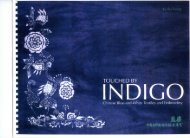2005, Justin Jennings, Kathy L. Antrobus, Sam J. Atencio, Erin ...
2005, Justin Jennings, Kathy L. Antrobus, Sam J. Atencio, Erin ...
2005, Justin Jennings, Kathy L. Antrobus, Sam J. Atencio, Erin ...
Create successful ePaper yourself
Turn your PDF publications into a flip-book with our unique Google optimized e-Paper software.
jennings et al. Alcohol Production in the Ancient World F 285<br />
kee and Goswell 1977:325). Wine was commonly served<br />
in large quantities in ancient Egypt and Mesopotamia<br />
(Fales 1994:370; Grivetti 1995:11; Lesko 1978:4). Wine<br />
was a symbol of power and status in these societies<br />
(Lesko 1978:3; Joffe 1998:302) and tended to be used in<br />
feasts that signaled social differences (see, e.g., Dietler<br />
2001:85).<br />
The techniques used to make wine in the ancient Near<br />
East were similar in broad outline to the ones used by<br />
vintners today (fig. 5) Grape vines required constant attention<br />
(Sasson 1994.401)—among other activities, trellises<br />
were built and maintained, grazing animals were<br />
kept at bay, dormant vines were pruned, and plants were<br />
watered (Jackisch 1986:39; Lesko 1977:15; Murray 2000a:<br />
584; Olmo 1995:37; Powell 1995:104; Zohary 1995:23).<br />
All of this work had to be done throughout the life of a<br />
vine even though the plant did not produce grapes usable<br />
for wine production during its first three to five years of<br />
life (Sasson 1994:401; Joffe 1998:300). When grapes were<br />
harvestable, workers picked the fruits, often by hand or<br />
with a sharp blade or stone, and put them in baskets that<br />
were carried to a treading area (Lesko 1977:17; McGovern<br />
2003:89; Montet 1958:106; Murray 2000a:585).<br />
A two-step process was used to extract the juice from<br />
the grapes. First, the grapes were thrown into vats and<br />
crushed by workers walking barefoot over them (Lesko<br />
1977:17; Montet 1958:106; Murray 2000a:586; Wilson<br />
1988:31). The juice flowed into pottery containers<br />
through holes near the bottom of the vats (Lesko 1977:<br />
19; Lutz 1922:53; Murray 2000a:586; depictions from Old<br />
Kingdom Egypt do not show these containers [McGovern<br />
2003:90]). The second stage in the pressing process was<br />
designed to capture the remaining juices from the<br />
treaded grapes. The treaded grapes, including stems,<br />
seeds, and skins, were placed in a sack. Workers twisted<br />
either the two ends of the sack, poles tied to the sides<br />
of the sack, or one side of the sack with the other side<br />
tied to a fixed pole to press the remaining juice out of<br />
the mixture (Lesko 1977:19; Lutz 1922:54–55; Murray<br />
2000a:588–89; Montet 1958:106–7; Wilson 1988:31). The<br />
juice that was extracted at this second stage was either<br />
added to the juice from the treading or fermented separately<br />
(Murray 2000a:590).<br />
The conversion of sugar to alcohol began quickly when<br />
the sugar-rich grape juice came into contact with the<br />
natural yeasts found on the grape skins, on the walls of<br />
the jars, or on other winery equipment (Jackson 2003:<br />
230; Lesko 1977:20; Murray 2000a:590). In this process,<br />
now called maceration, there were a number of yeasts<br />
and molds that could initially prosper in the sugary, hypertonic<br />
juice (Kunkee and Goswell 1977:344–50). As alcohol<br />
content rose and tannins were released, almost all<br />
of these microorganisms died off and only varieties of S.<br />
cerevisiae could thrive (Jackson 1999:603–5; Joshi, Sandhu,<br />
and Thakur 1999:656). In modern winemaking,<br />
maceration occurs after crushing (by treading or mechanical<br />
means) but before the wine is pressed and allowed<br />
to complete its fermentation (Jackson 2003:229).<br />
In the case of the ancient Near East, it is unclear if maceration<br />
was a separate step in the operational chain or<br />
Fig. 5. The operational chain for making grape wine.<br />
occurred in the fermenting jars when pressed juice was<br />
mixed with juice from treading that still contained stems<br />
and skins (Ghalioungui 1979:10; Lesko 1977:20). Since<br />
prolonged contact with grape skins adversely impacts a<br />
wine’s taste, it is likely that the juice from treading was<br />
strained at some point in the process (Murray 2000a:591).<br />
White wine, if it was made, was likely strained after a<br />
brief maceration time (a few minutes to a few hours),<br />
since prolonged exposure to grape skins changes the<br />
color of the wine (Lesko 1977:18; McGovern 2003:152;<br />
Murray 2000a:591; Jackson 2003:229).<br />
Primary fermentation in large-mouthed jars took from<br />
a few days to a few weeks depending on weather conditions<br />
and the type of wine desired (Murray 2000a:590),<br />
with a three-to-four-day fermentation period being perhaps<br />
most likely (Jackisch 1986:19). Wine jars may have<br />
been left outside to speed fermentation, although there<br />
is some evidence for cooler and slower fermentation<br />
(Murray 2000a; Wilson 1988:31). After fermentation<br />
slowed, the wine was either transferred into smallermouthed<br />
jars or allowed to remain in the fermenting jars.<br />
In both types of vessels, the jars’ mouths were likely<br />
sealed with semipermeable stoppers of reeds or papyrus<br />
and then with a layer of mud and straw. A small hole<br />
was sometimes left in the plaster to allow carbon dioxide<br />
to escape (Lesko 1977:20; McGovern 2003:88; Murray<br />
2000a:591; Wilson 1988:31). In these cases, the holes<br />
would be sealed a week or so later to prevent exposure<br />
to oxygen after final fermentation was complete (Jackisch<br />
1986:19; McGovern 2003:55).<br />
Wine was not racked and allowed to mature as it is
















